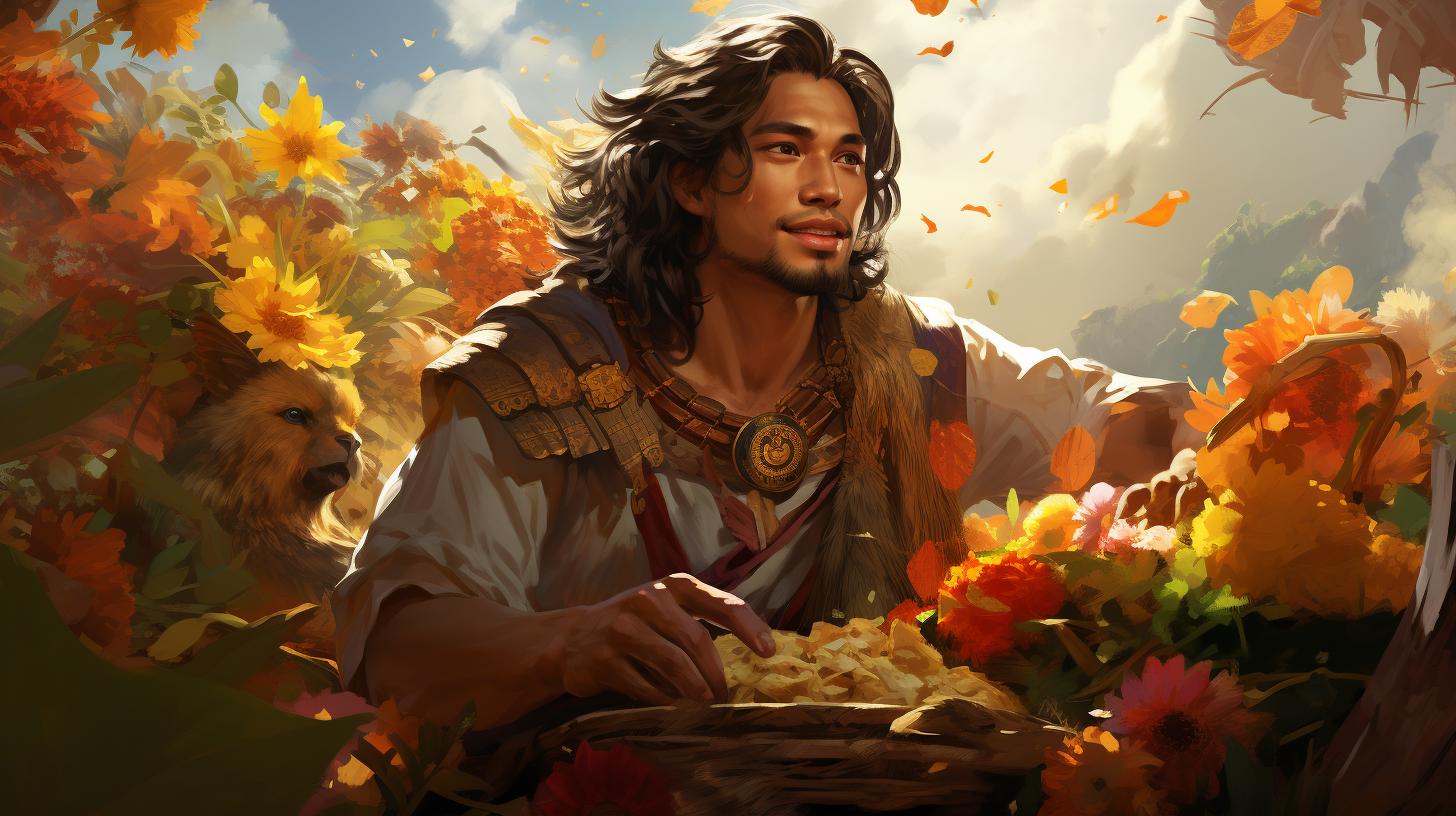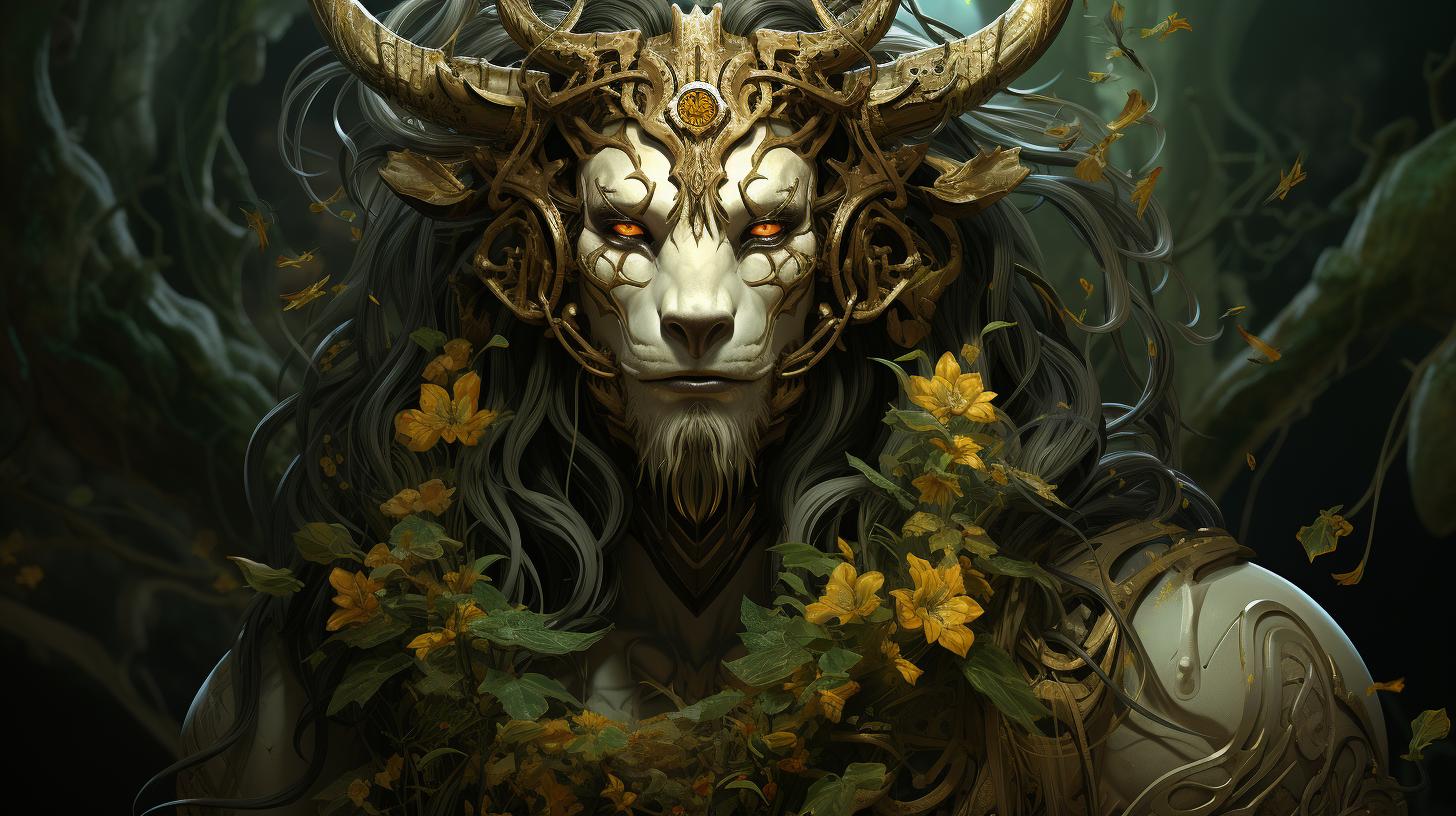Lalahon Goddess: Unearthing the Truth Behind the Visayan Harvest Deity

Lalahon goddess is a prominent figure in Visayan mythology, revered as the deity of bountiful harvest and agriculture. This article delves into the misconceptions surrounding Lalahon’s connection to fire and volcanoes, shedding light on her true identity.
Explore the origins and significance of Lalahon in Filipino folklore, rituals carried out to appease her for fruitful harvests, and her presence in contemporary culture. Discover the connections between Lalahon and other nature-based deities in Philippine mythology, and learn about ongoing efforts to preserve and rediscover her legacy through archaeological and historical findings.
The Myth of Lalahon Goddess: Exploring the Misconceptions and Legends
Unveiling the truth behind the enigmatic Lalahon goddess in Visayan mythology is a journey filled with misconceptions, legends, and intriguing tales. This ancient deity, often associated with the bountiful harvest and agriculture, holds a significant place in Filipino folklore.
However, the understanding of Lalahon has been muddled by misinterpretations and historical inaccuracies.
Legends surrounding Lalahon have been clouded by a misleading association with fire. Early historians mistakenly attributed her to be the goddess of fire, perpetuating a misunderstanding that has persisted for generations.
The truth, however, reveals that Lalahon’s role is far from the realm of flames and infernos.
The fascinating exploration into the origins and significance of Lalahon unravels a multi-faceted mythology that highlights her true identity.
In the rich tapestry of Visayan folklore, Lalahon is known by various names, such as Laon, Malaon, Raom, Makapatag, Laon Sina, Alunsina, and Kanlaon. Each name carries a unique essence, inviting deeper insight into the goddess’s character and influence.
Deep-rooted misconceptions about Lalahon can be traced back to inventive narratives derived from a lack of historical records and contemporary beliefs in rural and indigenous communities. These imaginative tales have perpetuated false notions, distorting the true essence of this revered deity.
As we embark on this journey to explore the myths and legends surrounding Lalahon, we must approach the subject with discernment and seek out reliable sources of information. Countless narratives have been built upon a foundation of invention and speculation, leading to a distorted understanding of this powerful goddess.
By delving into the rich tapestry of Lalahon’s mythology and separating fact from fiction, we can gain a clearer understanding of her true nature and significance in Visayan culture. Through careful examination and critical analysis, we can begin to unravel the layers of misconceptions that have shrouded this captivating deity for centuries.
- Unmasking the Mistranslation: Lalahon’s True Connection
- Dispelling the Volcanic Myth: Lalahon and Her Proximity to Kanlaon
- Redefining Lalahon’s Role: The Deity of Harvest and Agriculture
- Rituals and Offerings: Seeking Favor from the Harvest Goddess
Join us as we embark on a captivating exploration of Lalahon’s mythology and unearth the truth behind the misconceptions and legends that have enveloped her legacy.
Origins and Significance of Lalahon in Filipino Mythology
In Filipino mythology, Lalahon holds a significant position among the deities worshipped by the Visayan people. Her origins are shrouded in ancient legends and stories, passed down through generations, offering insights into her divine nature.
As one delves into the rich tapestry of Filipino folklore, the true significance of Lalahon begins to unfold.
Believed to be the goddess of harvest and agriculture, Lalahon is revered for her ability to bring prosperity to the farming communities of Visayas.
She is often associated with fertility and abundance, symbolizing the bountiful crops that sustain the livelihood of the people.
While Lalahon’s exact origins are subject to speculation, her presence in Visayan mythology predates written records.
The stories surrounding her are deeply ingrained in the cultural fabric of the region, embodying the values and beliefs of the ancestral Filipinos.
Lalahon’s significance lies not only in her role as the deity of harvest but also as a guardian of nature and protector of the land.
She embodies the symbiotic relationship between humans and the environment, emphasizing the importance of balance and stewardship.
Divine Connections and Cultural Influences
Lalahon’s influence extends beyond Visayas, as evident in her connection to other deities in Filipino mythology. In some narratives, she is identified as a sister or consort to Kanlaon, the god of the mountains and volcanoes.
These divine alliances illustrate the interconnectedness of various aspects of nature and the divine realm.
Over time, Lalahon’s significance has woven into the fabric of Filipino culture. Rituals and ceremonies dedicated to her are carried out in reverence to ensure successful harvests and to seek her blessings.
These rituals reflect the deep-rooted belief in her power and the enduring bond between humanity and the divine.
Preserving the Legacy of Lalahon
In recent years, efforts have been made to document and preserve the stories and rituals surrounding Lalahon. Archaeological and historical discoveries provide important insights into her mythological significance. These findings shed light on the religious practices and cultural traditions of the Visayan people, ensuring Lalahon’s legacy lives on.
Through continued research and exploration, scholars and enthusiasts aim to unearth further details about Lalahon’s origins and her place within the broader landscape of Filipino mythology. By delving deeper into her significance, we unravel the tapestry of Visayan culture and gain a deeper appreciation for the interplay between gods, humans, and the forces of nature.
Unveiling the True Identity of Lalahon: Separating Fact from Fiction
The true identity of the Lalahon goddess has long been shrouded in misconception and misinformation. In this section, we will explore the facts and dispel the fiction surrounding this enigmatic deity.
Clearing the Mistranslation: Lalahon’s Connection to Fire
One of the biggest misconceptions about Lalahon is her supposed connection to fire. Early historians wrongly translated her as the goddess of fire, which led to a distorted perception of her role in Visayan culture.
However, extensive research and analysis have revealed that there is no evidence to support this association. Lalahon is not a deity of fire, but rather, she is primarily known as the goddess of the harvest and agriculture.
Dispelling the Volcanic Myth: Lalahon and Her Proximity to Kanlaon
Another prevailing myth surrounding Lalahon is her alleged relationship with volcanoes, specifically the active Mount Kanlaon located in the island of Buglas. While it is true that Lalahon’s abode is near Mount Kanlaon, this does not make her a deity of volcanoes or volcanic activity.
Instead, her proximity to the mountain is simply a geographical fact rather than a basis for associating her with fire or volcanic worship.
Lalahon, also known by various names like Laon, Malaon, Raom, Makapatag, Laon Sina, Alunsina, and Kanlaon, holds a significant place in Visayan mythology as the goddess of bountiful harvests.
She is revered by farming communities, and rituals and offerings are made to appease her for the abundance of crops.
It is essential to separate fact from fiction and rely on credible sources when exploring the true identity of Lalahon.
Misconceptions and inaccurate translations can distort our understanding of this fascinating deity and her role in Filipino folklore. By delving deeper into the origins and significance of Lalahon, we can gain a more accurate understanding of her true identity and her importance in Visayan culture.
Stay tuned for the next section, where we will explore Lalahon’s role as the deity of harvest and agriculture in further detail.
Lalahon’s Role as the Deity of Harvest and Agriculture
As the revered goddess of harvest and agriculture in Visayan mythology, Lalahon holds a significant role in the lives of the local farming communities.
Her influence permeates through their daily activities, shaping their traditions, and guiding their agricultural practices.
Lalahon’s Influence on Visayan Farming Communities
Lalahon’s presence is deeply intertwined with the agricultural practices of the Visayan people. Her role goes beyond being a mere deity; she is considered the ultimate guardian of their crops and the bringer of abundant harvests.
Visayan farmers look to Lalahon for guidance and blessings throughout the various stages of the farming cycle. They believe that honoring her and seeking her favor ensures the fertility of their lands, protection from pests and diseases, and favorable weather conditions for prosperous yields.
Lalahon’s influence is not limited to the material aspects of farming; she is also associated with the spiritual and cultural well-being of the farming communities. Her presence fosters a sense of connection to nature and a deep appreciation for the land and its fruits.
Rituals and Offerings to Appease Lalahon for Bountiful Harvests
To appease and honor Lalahon, the Visayan people perform elaborate rituals and offer various items as tokens of gratitude and reverence. These rituals serve as a way to establish and maintain a harmonious relationship with the goddess, ensuring her continued blessings upon their agricultural endeavors.
- Ceremonial Offerings: Visayan farmers prepare intricate offerings, including fresh produce, flowers, and traditional delicacies, which are presented to Lalahon during specific harvest festivals and sacred ceremonies.
- Prayers and Chants: Prayers and invocations are recited to seek Lalahon’s favor and protection.
Chants and hymns dedicated to the goddess are sung during planting, harvesting, and other agricultural rituals, creating a bond between the farmers and the deity.
- Sacred Sites and Altars: Farmers often maintain sacred sites or altars dedicated to Lalahon within their farmlands.
These are adorned with symbols and images associated with the goddess, serving as focal points for offerings, prayers, and rituals.
Through these rituals and offerings, the farmers express their gratitude for the blessings received and demonstrate their commitment to the preservation of their agricultural heritage.
In conclusion, Lalahon’s role as the deity of harvest and agriculture is deeply ingrained in the lives of Visayan farming communities. Her influence extends beyond the material aspects of farming, fostering a sense of spirituality and cultural identity among the people.
By honoring her through rituals and offerings, the farmers seek to maintain a harmonious relationship with Lalahon and ensure bountiful harvests for generations to come.
Lalahon in Contemporary Culture: Perceptions and Beliefs
In present-day Filipino society, Lalahon continues to hold a significant place in the hearts and minds of many.
Her worship and reverence have persisted through generations, showcasing the enduring faith in this ancient deity.
Present-Day Worship and Reverence for Lalahon
Lalahon’s followers, particularly in the Visayas region, have preserved and passed down traditional rituals and practices dedicated to honoring the goddess. These rituals often involve offerings of food, prayers, and communal gatherings to seek her blessings for bountiful harvests and protection from agricultural perils.
Devotees also demonstrate their devotion by constructing shrines and altars dedicated to Lalahon, adorned with images and symbols representing her attributes and association with agriculture. These sacred spaces serve as focal points for worship and acts of gratitude.
Lalahon’s Presence in Folklore, Art, and Literature
Lalahon’s influence extends beyond religious practices and permeates various forms of cultural expression. She features prominently in Filipino folklore, where her stories are passed down through generations, narrated during community gatherings, and recited during cultural celebrations.
Artists and artisans have also drawn inspiration from Lalahon, depicting her in paintings, intricate sculptures, and handicrafts. These creative interpretations capture the essence of the goddess, emphasizing her connection to nature, fertility, and the cycle of life.
Moreover, Lalahon’s significance resonates in literature, where her character and mythology are explored through prose, poetry, and contemporary adaptations. Writers and poets evoke her presence to shed light on the cultural heritage, spiritual practices, and the enduring relationship between humans and nature.
Overall, Lalahon’s influence in contemporary culture serves as a testament to her enduring legacy. She continues to captivate the imagination, inspire artistic expression, and evoke a sense of connection to the land, reminding us of the importance of honoring and preserving our cultural heritage for future generations.
Exploring Related Deities and Myths in Philippine Folklore
In this section, we delve into the fascinating realm of Philippine folklore, uncovering the interconnectedness of deities in the Visayan pantheon and their enchanting myths. These tales provide a rich tapestry of cultural heritage, shedding light on the complex web of relationships between Lalahon and other nature-based deities.
Alunsina, Laon, and the Pantheon of Visayan Deities
Within the vast pantheon of Visayan deities, Alunsina and Laon hold significant positions alongside Lalahon. Alunsina, often revered as the supreme female deity, represents femininity, beauty, and harmony. Laon, on the other hand, embodies wisdom, eternity, and the ability to shape destiny.
Exploring the myths and legends surrounding Alunsina and Laon uncovers their contributions to the cosmic balance in Visayan mythology.
Connecting Lalahon to Other Nature-Based Deities in Philippine Mythology
Beyond her immediate counterparts, Lalahon also shares connections with various nature-based deities scattered throughout Philippine mythology. These include powerful beings associated with mountains, rivers, and forests, each representing different aspects of the natural world.
By examining these connections, we gain a deeper understanding of Lalahon’s role within the intricate tapestry of Philippine mythological traditions.
Through exploration of related deities and their myths, we unravel the complex relationships that intertwine with Lalahon’s story, shedding light on the broader cosmology and belief system that shaped Visayan culture.
Understanding these connections brings us closer to unraveling the intricate web of Philippine folklore and the profound significance of Lalahon within it.
Unearthing Lalahon’s Legacy: Conservation and Rediscovery Efforts
The conservation and rediscovery of Lalahon’s mythology and cultural significance have become crucial in the digital age. Efforts to preserve her legacy and ensure its accessibility have taken various forms.
Preserving Lalahon’s Mythology in the Digital Age
In this digital era, preserving Lalahon’s mythology has become a priority.
Online platforms and digital archives provide a means to safeguard and share her stories, rituals, and beliefs with a wider audience. Through carefully curated websites, articles, and multimedia resources, scholars and enthusiasts can contribute to the accurate representation and understanding of Lalahon’s role in Filipino mythology.
By leveraging digital tools and technologies, the retelling and archiving of Lalahon’s tales can transcend geographical boundaries and reach individuals around the world. Online communities dedicated to mythological studies provide platforms for knowledge exchange, furthering the preservation of Lalahon’s mythology and sustaining her cultural relevance.
Rediscovering Lalahon: Insights from Archaeological and Historical Discoveries
Archaeological excavations and historical research have contributed valuable insights into the rediscovery of Lalahon. By analyzing ancient artifacts, scriptures, and indigenous practices, researchers have pieced together fragments of Lalahon’s story.
Through careful examination of ancient texts, including oral traditions and epics, historians have uncovered hidden connections between Lalahon and other deities in Visayan folklore.
Bringing these findings to light allows for a deeper understanding of the intricate web of mythological beliefs surrounding Lalahon.
Furthermore, archaeological discoveries, such as temple ruins or sacred sites associated with Lalahon, provide tangible evidence of her existence and importance in ancient Visayan society.
These findings not only confirm the significance of Lalahon but also shed light on the customs and rituals performed to honor and appease her.
By combining the knowledge gained from archaeological and historical sources, researchers continue to piece together a comprehensive picture of Lalahon’s legacy, ensuring her story is accurately represented and appreciated for generations to come.
.




















